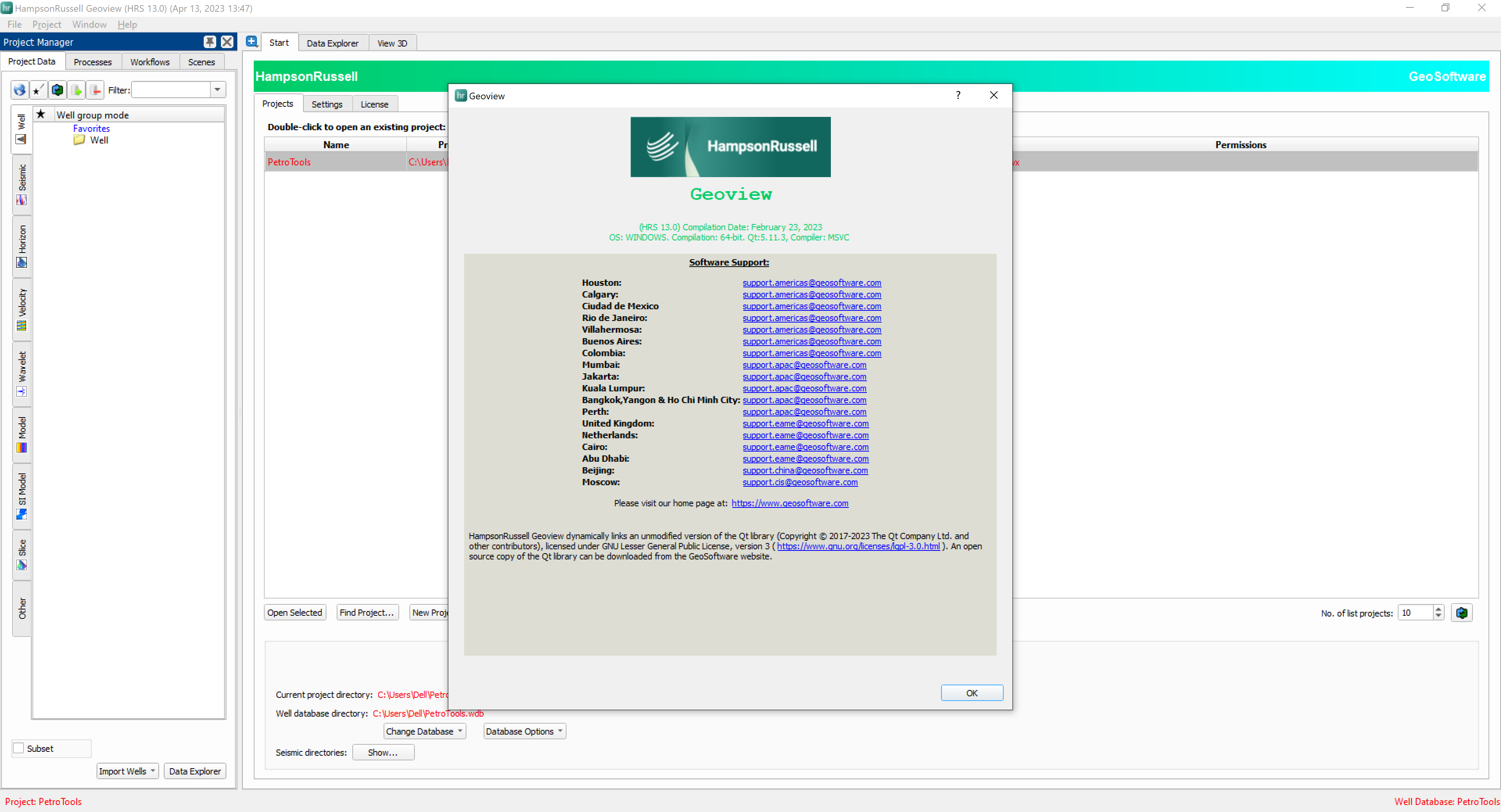تفسیر سایزمیک | CGG Hampson-Russell 13.0

Why Choose HampsonRussell? HRS 13.0 Reduce the risks and costs associated with exploration and production with world-class advanced geophysical interpretation and analysis from our HampsonRussell software. This comprehensive suite of reservoir characterization tools integrates well logs, seismic data and geophysical processes into an easily navigated, intuitive package for fast results. Known for its ease of use, HampsonRussell makes sophisticated geophysical techniques accessible.
Our software solutions help you better understand your reservoir and reduce risk in exploration and development decisions. New releases in the GeoSoftware portfolio integrate geoscience disciplines more deeply than ever before by bringing together geophysics, geology, petrophysics, rock physics and engineering.
Gain fresh insights into the most complex subsurface challenges in all types of reservoirs. Explore the latest GeoSoftware capabilities driven by technology innovation, workflow integration and ease-of-use.
Users can now run the GeoSoftware Petrel link in HampsonRussell and Jason and connect with the DELFI platform for greater ease-of-use and efficiency across the software platforms in your organization.
GeoAI:
GeoAI encompasses a novel methodology for seismic reservoir characterization with limited well control, speeding up reservoir property predictions with a rock physics driven machine learning technique. Rock Physics theory and statistical simulations generate synthetic data for various geological scenarios. A simplified machine learning approach employs Convolutional Neural Networks (CNN) estimating multiple rock property volumes in a greatly simplified workflow.
Benefits of GeoAI:
Improves Reservoir Characterization for low well-control areas
Allows direct prediction of facies and reservoir properties
Utilizes rock physics guided machine learning to optimize extraction of information and value addition from all available data
WellGen:
In standard supervised machine learning approaches, the seismic-to-rock property relationship is learned using available data. These methods, particularly deep learning, depend on having enough labeled data to adequately train the neural network. WellGen overcomes this challenge by generating synthetic data, simulating many pseudo-wells based on existing well statistics and rock physics modeling.
WellGen addresses common machine learning challenges, including:
Scarcity of wells within the study area
The difficulty of tying well data with seismic
High variability in the well curves not depicting geological variations
Inability to link geological and geophysical observations
Reservoir complexity that cannot be resolved by inversion alone
AVO:
AVO is a comprehensive HampsonRussell module for pre-stack data conditioning, attribute computation and analysis. This module has the tools for conditioning pre-stack seismic data to produce optimum attribute volumes, cross-plotting and interpretation functions for locating AVO anomalies, and AVO modeling tools for calibration. Customizable workflows and the integration of AVO tools into the Geoview interface make sophisticated AVO analysis simple.
Benefits of HampsonRussell AVO:
Provides a single comprehensive module for data conditioning, attribute calculation and analysis
High-grades pre-stack seismic data for inversions
Calibrates seismic data with model data
Enables simple navigation and comparison of multiple attribute volumes with seismic gathers
Strata
Strata performs both post-stack and pre-stack inversions. In the conventional post-stack domain, Strata analyzes post-stack seismic volumes to produce an acoustic impedance volume. In the pre-stack domain, Strata analyzes angle gathers or angle stacks to produce volumes of acoustic impedance, shear impedance and density.
Benefits of Strata:
Provides easy QC and inversion parameter optimization at well locations using inversion analysis
Enables access to multiple inversion techniques such as model-based, colored and sparse spike inversion algorithms
Produces elastic attribute volumes as outputs which are ideally suited to be used as inputs for Emerge attribute prediction, or LithoSI facies classification.
Emerge
Emerge is a geostatistical, attribute prediction module that can predict property volumes using well logs and attributes from seismic data. The predicted properties can be any log types available, such as porosity, velocity, density, gamma-ray, lithology and water saturation. Emerge can also be used to predict missing logs or parts of logs by using existing logs that are common to the available wells with deep learning and deep-feed neural network (DFNN) techniques.
Benefits of Emerge:
Enables non-linear, high-resolution predictions using neural networks
Gives the ability to predict volumes of any data type
Allows all data to be used during training through internal cross-validation
Derives a measure of correlation and error at each well used in the training
Enhances prediction of missing log data by using multi-log and non-linear combinations
GeoSI:
GeoSI is a geostatistical (single stack and multiple stack) inversion application that generates high-frequency stochastic models for high-resolution reservoir characterization and uncertainty analysis. It addresses the band-limited nature of deterministic inversion methods and integrates well data and seismic data at a fine scale within a stratigraphic geomodel framework.
Benefits of GeoSI:
Provides increased resolution integrating well and seismic data
Supports cascaded reservoir property simulation
Enables risk and uncertainty analysis using probability cubes
Facilitates interpretation and reservoir simulation by using a stratigraphic framework
More:
HampsonRussell ProAZ – ProAZ maps fractures and predicts stress by observing azimuthal variations in the P-wave seismic data. It provides a series of tools to enable interpreters to interactively explore for azimuthal variations in their datasets and generate azimuthal attributes to summarize the results.
HampsonRussell Multi-node Processing (MNP) – A utility that divides the processing of large seismic volumes into equal-sized segments, each segment using a different machine (node) in order to reduce the overall run time of the processing. It is most effective for heavy-computation tasks such as pre-stack inversion, where I/O limitations are not a bottleneck.
HampsonRussell Attributes – The Attributes package is designed to create and extract a collection of advanced single- and multi-trace seismic attributes to enhance your interpreting ability to quantify the reservoir properties in seismic volumes as well as perform data preconditioning such as noise reduction and data quality control. Download Attributes Flyer
HampsonRussell LithoSI – LithoSI quantifies uncertainty in seismic lithology and fluid prediction. Using multiple elastic parameters from the inversion of seismic data, LithoSI performs a supervised Bayesian classification to deliver probability cubes of predicted lithology or rock properties.
HampsonRussell MapPredict – MapPredict is a map-based geostatistical software that integrates well, seismic, and attribute data into accurate, detailed maps using both sparse data measured at isolated wellbores and dense data measured on a survey grid.
HampsonRussell Pro4D – Pro4D performs time-lapse modeling and interpretation for seismic data matching. A range of anticipated reservoir scenarios can be modeled to predict the seismic response to reservoir changes.
HampsonRussell ProMC – ProMC is an easy-to-use and intuitive work environment that offers interpreters the ability to handle the increased number of seismic and attribute volumes inherent in a multicomponent project. It addresses the challenges of differences in event times, frequencies, and reflectivity between PP and PS seismic volumes.
HampsonRussell Gather Conditioning – Gather Conditioning removes noise, provides consistent fold, time-aligns reflection events, and can be used to correct the background amplitude decay with offset calibrated using synthetic gathers generated from well logs. When input to processes such as AVO analysis, the conditioned gathers will result in more accurate and reliable results than the input of unconditioned gathers.
HampsonRussell Geoview – Geoview is a single intuitive interface that allows users to access their project data and processes from one centralized location. Geoview also includes a set of pre-loaded process workflows that can be easily customized and shared with other users, as well as batch and chained processing tools for improved efficiency.
HampsonRussell Advanced 3D Viewer – Advanced 3D Viewer is an add-on utility that offers enhanced 3D visualization and facilitates interactive display of results from HampsonRussell's GeoSI, LithoSI, ProAZ, and Attributes packages.
HampsonRussell RockSI – RockSI is a powerful tool for exploring the link between rock properties and seismic data for quantitative interpretation and feasibility studies.
تیم PetroTools آخرین نسخه این نرم افزار را برای شما ارائه می دهد. جهت تهیه نرم افزار با استفاده از منوی خرید با ما در تماس باشید
For buy software, Please contact us via buy menu



 O-Sense
O-Sense
